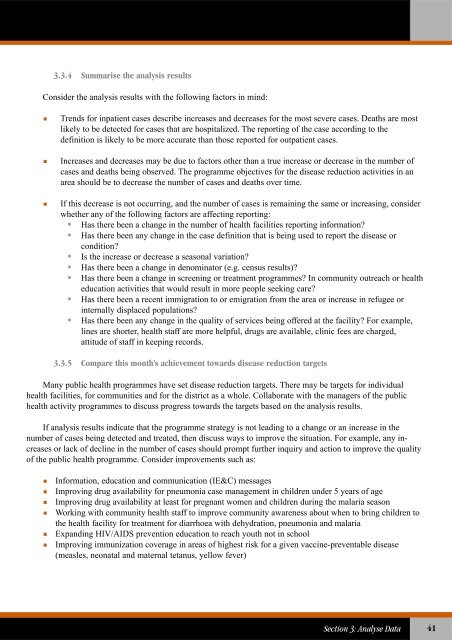Technical Guidelines for Integrated Disease Surveillance ... - PHRplus
Technical Guidelines for Integrated Disease Surveillance ... - PHRplus
Technical Guidelines for Integrated Disease Surveillance ... - PHRplus
Create successful ePaper yourself
Turn your PDF publications into a flip-book with our unique Google optimized e-Paper software.
3.3.4 Summarise the analysis resultsConsider the analysis results with the following factors in mind:Trends <strong>for</strong> inpatient cases describe increases and decreases <strong>for</strong> the most severe cases. Deaths are mostlikely to be detected <strong>for</strong> cases that are hospitalized. The reporting of the case according to thedefinition is likely to be more accurate than those reported <strong>for</strong> outpatient cases.Increases and decreases may be due to factors other than a true increase or decrease in the number ofcases and deaths being observed. The programme objectives <strong>for</strong> the disease reduction activities in anarea should be to decrease the number of cases and deaths over time.If this decrease is not occurring, and the number of cases is remaining the same or increasing, considerwhether any of the following factors are affecting reporting: Has there been a change in the number of health facilities reporting in<strong>for</strong>mation? Has there been any change in the case definition that is being used to report the disease orcondition? Is the increase or decrease a seasonal variation? Has there been a change in denominator (e.g. census results)? Has there been a change in screening or treatment programmes? In community outreach or healtheducation activities that would result in more people seeking care? Has there been a recent immigration to or emigration from the area or increase in refugee orinternally displaced populations? Has there been any change in the quality of services being offered at the facility? For example,lines are shorter, health staff are more helpful, drugs are available, clinic fees are charged,attitude of staff in keeping records.3.3.5 Compare this month’s achievement towards disease reduction targetsMany public health programmes have set disease reduction targets. There may be targets <strong>for</strong> individualhealth facilities, <strong>for</strong> communities and <strong>for</strong> the district as a whole. Collaborate with the managers of the publichealth activity programmes to discuss progress towards the targets based on the analysis results.If analysis results indicate that the programme strategy is not leading to a change or an increase in thenumber of cases being detected and treated, then discuss ways to improve the situation. For example, any increasesor lack of decline in the number of cases should prompt further inquiry and action to improve the qualityof the public health programme. Consider improvements such as: In<strong>for</strong>mation, education and communication (IE&C) messages Improving drug availability <strong>for</strong> pneumonia case management in children under 5 years of age Improving drug availability at least <strong>for</strong> pregnant women and children during the malaria season Working with community health staff to improve community awareness about when to bring children tothe health facility <strong>for</strong> treatment <strong>for</strong> diarrhoea with dehydration, pneumonia and malaria Expanding HIV/AIDS prevention education to reach youth not in school Improving immunization coverage in areas of highest risk <strong>for</strong> a given vaccine-preventable disease(measles, neonatal and maternal tetanus, yellow fever)Section 3: Analyse Data41















